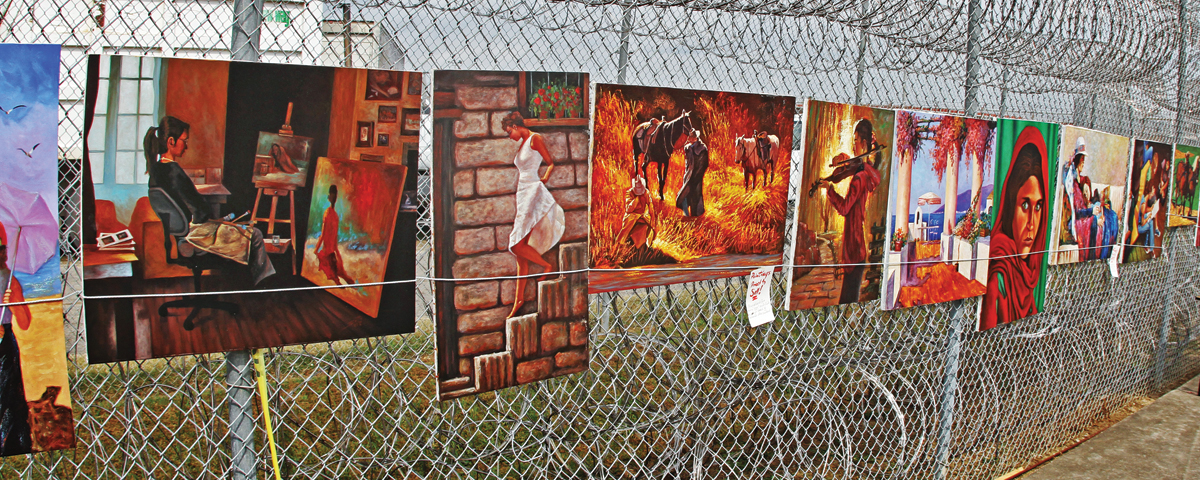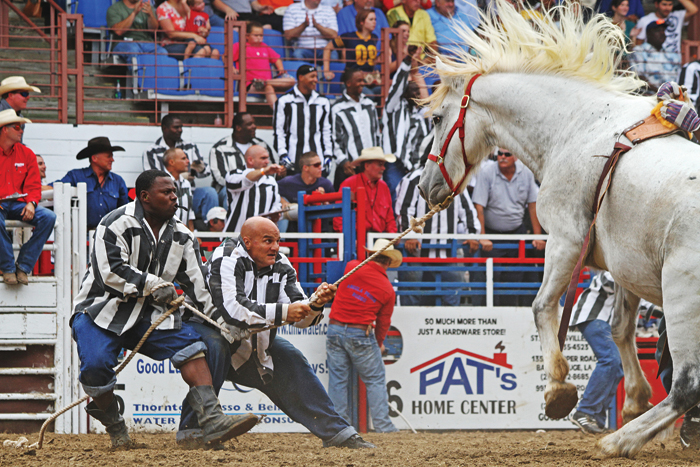Angola Prison Rodeo Angola Prison Rodeo Arts October 6

Ralph Dawson keeps decorated as he shows off his high-stop leatherwork—wallets, purses, etc.—to potential customers at his booth. He's smile, sharing his inspiration. This could exist an fine art bear witness anywhere in the country, but a glance at the postage on his paw-tooled leatherwork tells another story:
Designed & Handcrafted by:
Ralph Dawson—119581
Louisiana State Penitentiary
Life Without Parole
Since 1986
"Seventeen/eighteen years ago it was a hobby," Dawson says during a rare break in conversation. "Now I endeavor to brand it a business." His main goal? "To produce something that doesn't await like it was fabricated in prison house."
Dawson is serving a life sentence for second-caste murder at the maximum-security Louisiana Country Penitentiary, aka Angola, where roughly three-quarters of the more than half-dozen,000 inmates are serving life without parole. The boilerplate judgement for the remaining prisoners is 90.9 years.
Yet every Dominicus in October and the 3rd Saturday and Lord's day in April the prisoners are allowed to interact with the public during the Angola Prison Rodeo. Dating from 1965, information technology is the longest-running prison house rodeo in the nation. Effectually 100 inmates compete in everything from bulldogging to barrel racing. Just that'southward non the whole story. Ten times every bit many inmates contribute to the arts and crafts show that runs in conjunction with the rodeo.

"Some of what'south sold are definitely hobby and crafts," corrections supervisor Francis Abbott says. "Merely a lot of it is art. And you lot'll encounter people loading trailers with art. They come for this as much as the rodeo."
"The rodeo is of great benefit to the offender population," adds banana warden Gary Young, who oversees the program. The rodeo funds the prison's re-entry program, while the art show provides inmates fiscal advantage and a creative outlet. Certainly, too, performing for 11,000 cheering fans or selling a painting or tooled chugalug can boost self-esteem.
Participants in the arts and crafts bear witness must maintain a good conduct record, Immature explains. "The offenders who collaborate direct with the public are class A and B trustees," he says. "This means they have been at the facility for at least 10 years and accept a good conduct record." Some medium-custody inmates are allowed to negotiate arts and crafts sales from behind a fence. Maximum-security prisoners are prohibited from participation in both the craft show and the rodeo.
Like about of the rodeo participants, many of the artists acquire as they go. Have John Sheehan, whose leatherwork includes belts, spur straps and tack. "I first started by watching others, and then bought a how-to book and just started practicing," he says. Sheehan gleans his ideas from magazines, catalogs, TV—"whatever yous can get." As he is serving life without parole for 2d-caste murder, time is not a limiting gene. And art at Angola isn't limited to the booths. Prisoners refurbished a 1962 carousel that children ride during the rodeo. Inmates too painted murals on the prison's water tanks.
The rodeo itself is billed as the "Wildest Prove in the Due south," with events like "Bust Out" (in which six inmates on six bulls intermission from their chutes simultaneously) and "Guts & Glory" (in which participants endeavour to remove a poker chip tied to the forehead of a feisty Brahma bull).
The craft show isn't quite that wild, but it's only as important for the inmates. "With the art, it'due south all virtually imagination," explains Howard Ray, also serving life without parole for second-degree murder, who makes bowls and furniture. "I can exist and so artistic here," echoes Sheehan. "The imagination is the only thing that stops you." WW
martinezweept1969.blogspot.com
Source: https://www.historynet.com/angola-rodeo-arts-crafts/
0 Response to "Angola Prison Rodeo Angola Prison Rodeo Arts October 6"
Post a Comment